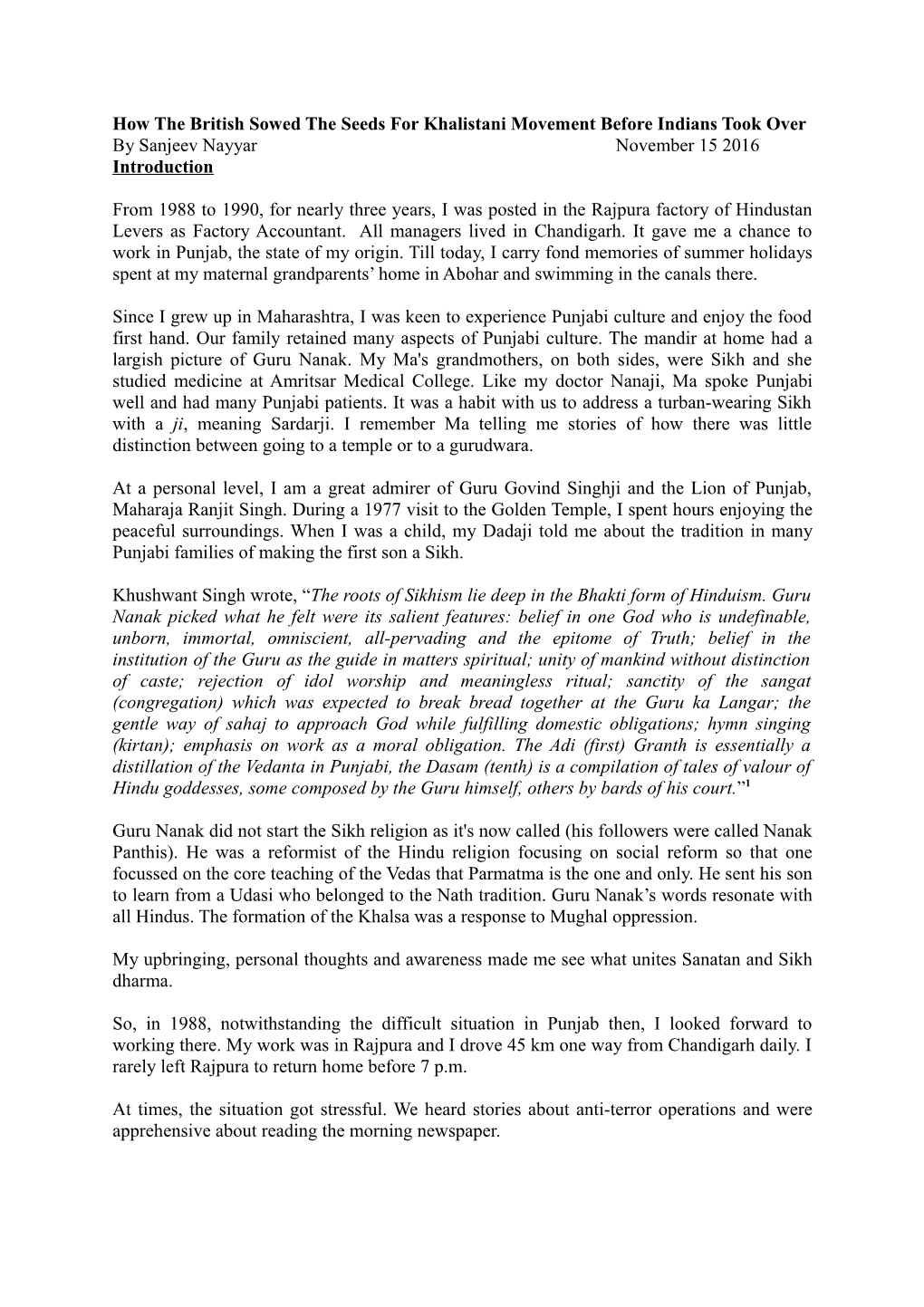How The British Sowed The Seeds For Khalistani Movement Before Indians Took Over
By Sanjeev Nayyar November 15 2016
Introduction
From 1988 to 1990, for nearly three years, I was posted in the Rajpura factory of Hindustan Levers as Factory Accountant. All managers lived in Chandigarh. It gave me a chance to work in Punjab, the state of my origin. Till today, I carry fond memories of summer holidays spent at my maternal grandparents’ home in Abohar and swimming in the canals there.
Since I grew up in Maharashtra, I was keen to experience Punjabi culture and enjoy the food first hand. Our family retained many aspects of Punjabi culture. The mandir at home had a largish picture of Guru Nanak. My Ma's grandmothers, on both sides, were Sikh and she studied medicine at Amritsar Medical College. Like my doctor Nanaji, Ma spoke Punjabi well and had many Punjabi patients. It was a habit with us to address a turban-wearing Sikh with a ji, meaning Sardarji. I remember Ma telling me stories of how there was little distinction between going to a temple or to a gurudwara.
At a personal level, I am a great admirer of Guru Govind Singhji and the Lion of Punjab, Maharaja Ranjit Singh. During a 1977 visit to the Golden Temple, I spent hours enjoying the peaceful surroundings. When I was a child, my Dadaji told me about the tradition in many Punjabi families of making the first son a Sikh.
Khushwant Singh wrote, “The roots of Sikhism lie deep in the Bhakti form of Hinduism. Guru Nanak picked what he felt were its salient features: belief in one God who is undefinable, unborn, immortal, omniscient, all-pervading and the epitome of Truth; belief in the institution of the Guru as the guide in matters spiritual; unity of mankind without distinction of caste; rejection of idol worship and meaningless ritual; sanctity of the sangat (congregation) which was expected to break bread together at the Guru ka Langar; the gentle way of sahaj to approach God while fulfilling domestic obligations; hymn singing (kirtan); emphasis on work as a moral obligation. The Adi (first) Granth is essentially a distillation of the Vedanta in Punjabi, the Dasam (tenth) is a compilation of tales of valour of Hindu goddesses, some composed by the Guru himself, others by bards of his court.”1
Guru Nanak did not start the Sikh religion as it's now called (his followers were called Nanak Panthis). He was a reformist of the Hindu religion focusing on social reform so that one focussed on the core teaching of the Vedas that Parmatma is the one and only. He sent his son to learn from a Udasi who belonged to the Nath tradition. Guru Nanak’s words resonate with all Hindus. The formation of the Khalsa was a response to Mughal oppression.
My upbringing, personal thoughts and awareness made me see what unites Sanatan and Sikh dharma.
So, in 1988, notwithstanding the difficult situation in Punjab then, I looked forward to working there. My work was in Rajpura and I drove 45 km one way from Chandigarh daily. I rarely left Rajpura to return home before 7 p.m.
At times, the situation got stressful. We heard stories about anti-terror operations and were apprehensive about reading the morning newspaper.
When I look back and reflect, the questions that come to mind are: how did things get so bad, who divided Punjab and set back the state by at least twenty years? Questions like these goaded me to write this essay.
Simply put, it is the British who sowed the seeds for the Khalistan movement by dividing Punjabi society into Hindu and Sikh. They did this starting the 1860's. Post independence, what started as a game for political power snowballed into a terror movement, aided by Pakistan who wanted to do a Bangladesh to India.
This essay gives a comprehensive view of key events in Punjab between the 1860s and 1995. It is not my intent to reignite the divide between Punjabis—Hindus and Sikhs. For me, the two are bound forever by an unbreakable bond of history and kinship including marriage.
This piece is based on inputs from three must-read books on Punjab—Amritsar; Mrs Gandhi's Last Battle (Mark Tully and Satish Jacob) and A History of Sikhs, Volumes I andII (Khushwant Singh). I have tried to be as factual as possible. Where possible, facts are interspersed with personal experiences. Errors and criticism are solely to my account.
The e book is divided into four parts. Against each part given its contents and links.
Part 1 covers: A snapshot of key events in 1699 and then from the 1860s to 1995.
Part 2 covers: A history of Punjab for the same periods. The birth of Khalsa; why Sikhs joined the Royal Indian Army in large numbers; how the British sowed the seeds for the Khalistani Movement; Hindu-Sikh relations; Tat Khalsa Movement; birth of Akali Dal and different Sikh sects.
Part 3 covers: Key political developments between 1948 and 1980, including the beginning of terrorism in Punjab; emergence of Bhindranwale; Operation Blue Star.
Part 4 covers: The Sikh mutiny post Operation Blue Star; the Rajiv-Longowal Accord; Operation Black Thunder II; peak of killings; crushing of terrorism and Conclusion.
Look forward to your feedback.
Also readThe Nanak Our ‘Establishment’ Historians Don’t Want You To Know About by Aravindan N
